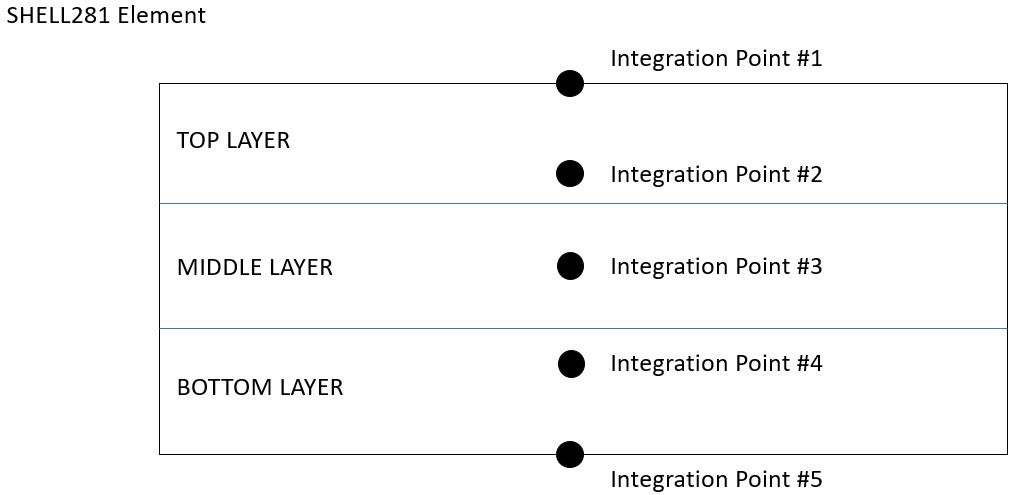TAGGED: integration-point, shell281
-
-
May 29, 2022 at 12:23 am
Matthew Pirkle
SubscriberI am using the SHELL 281 element with 5 integration points, and I find that the stress results at the TOP, MIDDLE, and BOTTOM layers are exactly the same. Why is this? Does ANSYS take the average of the 5 integration points, and use that as the same result for the TOP, BOTTOM, and MIDDLE layers?
Here is some of the code I am using:
ET,1,SHELL281
KEYOPT,1,8,1
KEYOPT,1,1,1
Thanks!
-
May 29, 2022 at 4:33 am
peteroznewman
SubscriberIf the shell elements were subjected to In-plane loads only and no bending loads, then you would expect the stress in the shell to be equal top to bottom.
-
May 30, 2022 at 3:29 pm
Matthew Pirkle
SubscriberYes, the loading is in-plane only with no bending.
If I am using the SHELL 281 element with 5 integration points (SECDATA,t,1,0.0,5), while also using reduced integration (ET,1,SHELL281), I should wind up with only 4 integration points through the thickness of the SHELL 281 element. Correct?
In the event that the SHELL 281 elements were subjected to bending loads, how does ANSYS arrive at the stress results for the TOP, MIDDLE, and BOTTOM layers if 4 integration points (reduced integration) are used? Is the MIDDLE the result of the average of the 4 integration points, or perhaps the average of the 2 integration points immediately above and below the mid-plane of the element?
Thank you!
Thank you so much!
-
June 1, 2022 at 10:38 am
peteroznewman
SubscriberIntegration points are In-Plane which is independent of the number of Layers through the thickness, which is in an orthogonal direction. You will still have 5 layers whether you use Reduced Integration or not.
Stress in the Middle layer is based on the In-Plane (also called Membrane) loads.
Stress in the Top and Bottom layers is based on the Bending loads vectorially added to the In-Plane loads. That means if the sheet has in-plane tension, and by bending has more tension on the top and less tension (or compression) on the bottom, then the stress is higher on the top than the bottom.
-
September 24, 2022 at 3:14 pm
Matthew Pirkle
SubscriberThe loading is In-Plane only (uniaxial tension test). If I understand correctly, the question becomes:
For In-Plane loading, when using reduced integration on the SHELL281 element with 5 integration points, there will still be 5 integration points through the thickness of the element. Because the loading is In-Plane only, one expects that the stress results will be the same no matter which layer in the shell element they are taken from (TOP, MIDDLE, or BOTTOM). When using the Options for Output in ANSYS and selecting the MIDDLE LAYER of the SHELL281 element, does ANSYS ordinarily compute the maximum stress output from the MIDDLE LAYER as the maximum of the 5 integration points, the average of the 5 integration points, or the extrapolation of the stress to the nodes?
Thank you so much!
-
-
October 22, 2022 at 3:11 pm
Matthew Pirkle
SubscriberThe loading is In-Plane only (uniaxial tension test). If I understand correctly, the question becomes:
For In-Plane loading, when using reduced integration on the SHELL281 element with 5 integration points, there will still be 5 integration points through the thickness of the element. Because the loading is In-Plane only, one expects that the stress results will be the same no matter which layer in the shell element they are taken from (TOP, MIDDLE, or BOTTOM). When using the Options for Output in ANSYS and selecting the MIDDLE LAYER of the SHELL281 element, does ANSYS ordinarily compute the maximum stress output from the MIDDLE LAYER as the maximum of the 5 integration points, the average of the 5 integration points, or the extrapolation of the stress to the nodes?
Thank you so much!
-
- The topic ‘SHELL 281 Stress Results’ is closed to new replies.


- The legend values are not changing.
- LPBF Simulation of dissimilar materials in ANSYS mechanical (Thermal Transient)
- Convergence error in modal analysis
- APDL, memory, solid
- How to model a bimodular material in Mechanical
- Meaning of the error
- Simulate a fan on the end of shaft
- Real Life Example of a non-symmetric eigenvalue problem
- Nonlinear load cases combinations
- How can the results of Pressures and Motions for all elements be obtained?

-
4092
-
1487
-
1318
-
1156
-
1021

© 2025 Copyright ANSYS, Inc. All rights reserved.









